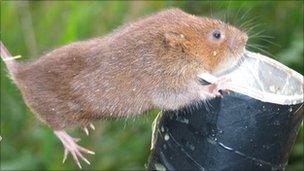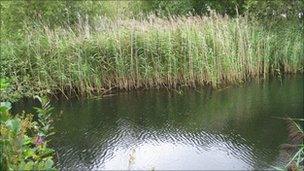Brandon Marsh: Water voles return to the reserve
- Published

Water voles are thought to be the UK's fastest declining mammal
A creature made famous in the classic children's story Wind in the Willows has been given a helping hand in Warwickshire.
The county's water vole population is thought to have been doubled in one day after 200 of the elusive animals were released into the wild.
The project aims to give the mammals a safe haven in a former gravel quarry.
Brandon Marsh Nature Reserve offers 228 acres of open water, wetland and grassland for the new population to re-establish itself in.
Water voles were recorded in the reserve in the 1940s and 50s but then a combination of pollution, loss of habitat and predation by American mink led to the creature's catastrophic decline.
The animals are now thought to be the UK's fastest declining mammal.
Perfect habitat
But following the creation of the reserve in 1968 nature has gradually returned to the quarry which is now a sanctuary for birds, plants, fungi and insects.

The project aims to give the mammals a safe haven in a former gravel quarry
For Stephen Trotter, chief executive of Warwickshire Wildlife Trust, the release shows how far the reserve has developed.
He said: "It's absolutely brilliant for all of our staff.
"It's a culmination of many years of hard work getting the reserve into tip top condition.
"The habitat is perfect for the water voles now."
The water voles were bred in a captive breeding programme based in Devon.
They were born in May or June and are about half-grown.
It is hoped they will spend the winter acclimatising and digging holes to live in before they start to breed in the spring.
Eventually animals may leave the reserve and spread to other areas around the county.

The water voles were bred in a captive breeding programme earlier this year
And to see how far they go 15 of them have been fitted with radio trackers, funded by Aston University.
Middlemarch Environmental Limited have been advising the wildlife trust on the release.
Jemma Gaskin, principal ecologist for the firm, said they were releasing the water voles using a mixture of "hard" and "soft" release - this means some animals are released instantly while others, which weigh less than 160g, spend three days in a box in the wild where they can be fed.
After three days a small door is opened in the box and the water voles are free to leave.
Messing about on the river
"It is hoped that if we establish a strong and successful breeding population here at Brandon, the water voles will disperse and help repopulate former water vole sites within Warwickshire" she added.
The release project is part of a research study into water vole conservation including habitat re-creation and reinstatement.
The project has been funded by Biffaward in partnership with Severn Trent Water, Middlemarch Environmental Ltd and Warwickshire Wildlife Trust.
It is also supported by the Environment Agency, Natural England, local landowners and the Brandon Marsh Voluntary Conservation Team.
It is hoped the reserve's new residents will bring more visitors to the site hoping to catch a glimpse of "Ratty" messing about on the river.
Mr Trotter said: "I hope it brings more people to the reserve to spend time out and about in the hides and on the network of paths looking for water voles which will add to their experience at Brandon Marsh."
- Published2 August 2011
- Published30 July 2011